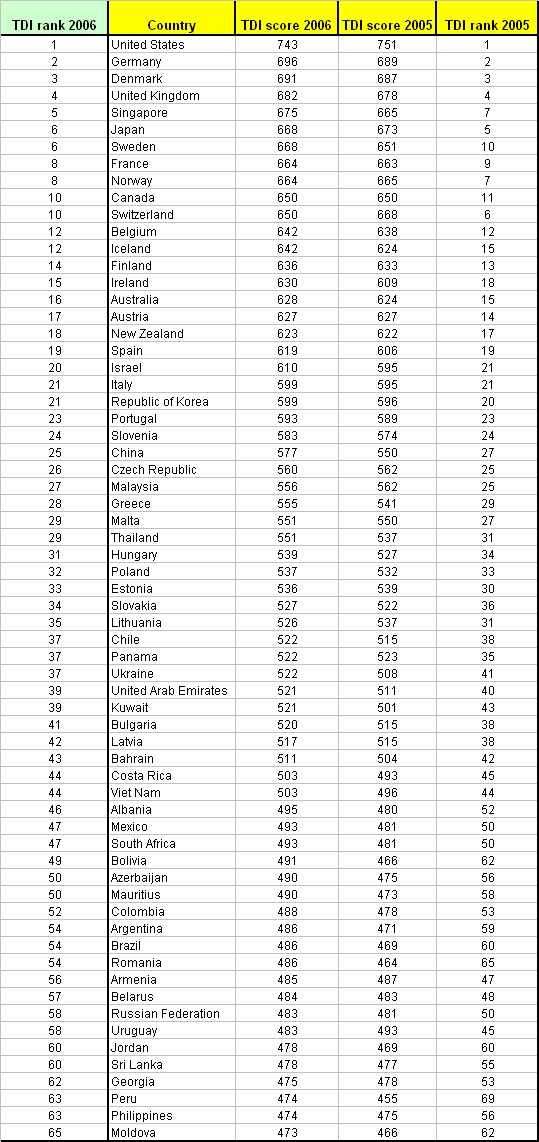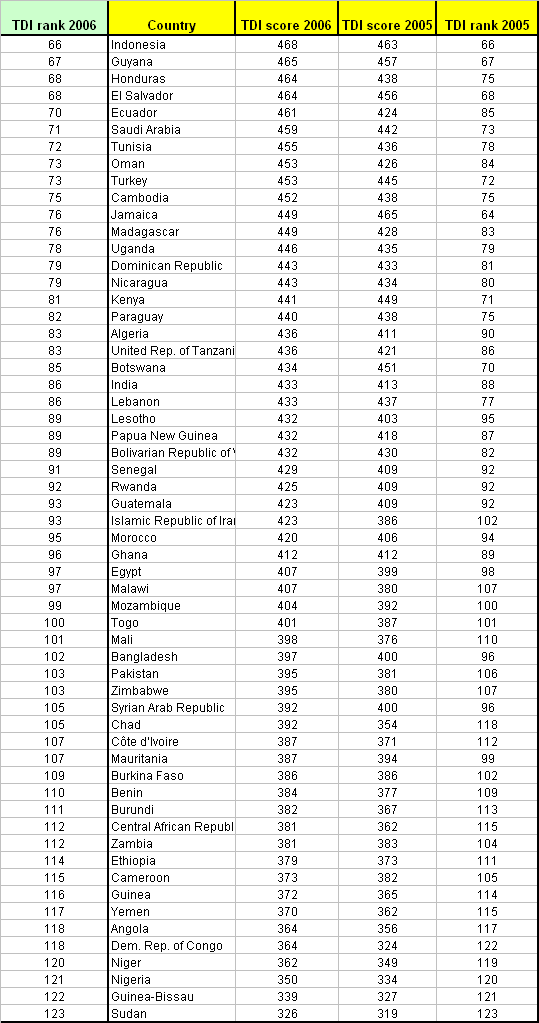| EMBARGO The contents of this press release and the related Report must not be quoted or summarized in the print, broadcast or electronic media before 6 November 2007, 17:00 GMT |
Under revised TDI methodology, the United States tops rankings, followed by Germany, Denmark and the United Kingdom; Singapore, highest-rated developing country, is in 5th place
The United States still has the world´s best combination of economic, social, regulatory, and government attributes for engaging in and benefiting from global trade and for using the benefits to raise living standards, according to the annual UNCTAD study, despite quite recent economic and social difficulties associated with the macroeconomic imbalances, weakening dollar and housing market crunch.
Singapore, at number 5, was the highest-rated developing country in 2006. It was also the only developing country in the top 20. The Republic of Korea placed 21st, China 25th, Malaysia 27th, and Thailand 29th. South Africa (47th) and Mauritius (50th) held the top spots among African nations. The 20 countries at the bottom of the TDI ranking at are either least developed countries (LDCs) or sub-Saharan African countries. Seven countries with economies in transition - South-Eastern Europe and Commonwealth of Independent States, including the Russian Federation - achieved positive improvements in TDI scores as compared to 2005. The highest increase was in Romania, followed by Azerbaijan and Albania.
The Index is reviewed and explained in detail in the UNCTAD publication Developing Countries in International Trade 2007- Trade and Development Index (1), released today. The TDI is a comprehensive review of global trade and development performance, integrating almost all key factors and indicators affecting trade and development in all countries, whether developing or developed. It was conceived to provide an innovative analytical and benchmarking tool to assess trade policies in interaction with development strategies at the national level in order to promote balanced economic and social development in developing countries, least developed and countries with economies in transition. The Index findings released in Geneva today looks at country-specific realities and points to the structural, institutional, or financial bottlenecks, as well as shortcomings in trade policy and socio-economic well-being.
In other words, the main purpose of the TDI is to help governments -- especially those struggling with poverty and sluggish development -- to determine what to do to participate more effectively in the global economy and to benefit from world trade to speed up national economic growth, create jobs, and improve general well-being.
This year´s TDI incorporates a number of refinements following suggestions from governments and the academic community. Three new components have been added to the structural and institutional context dimension: domestic finance resources, international finance resources, and macroeconomic stability. Two new components, trade performance and economic and social well-being have been added to the trade and development performance dimension. In addition, a number of new indicators have been added, including: gross domestic savings, total external debt service and short-term debt, regulatory quality and control of corruption, the inflation and current account balance, female to male income share and female labour force participation in total labour force, and the adult literacy ratio as an education indicator. As a result, the new TDI incorporates 11 components and 34 specific indicators.
On the basis of the index findings, developing countries continue to lag behind developed countries in areas such as human capital, physical infrastructure, financial intermediation, institutional quality, trade performance and economic and social well-being. However, the study points to an encouraging positive development: some developing countries have achieved scores that are close to those of developed countries in domestic finance, economic structure, macroeconomic stability and environmental sustainability. Most economies are now relatively comparable with respect to openness to trade. Yet the differences in other components indicate the limits to what trade openness alone can achieve in the absence of other key determinants of trade and development evolution.
"TDI is a valuable policymaking and policy-advocacy tool as it aims to assist UNCTAD member States to identify existing strengths and weaknesses of their institutional and policy environment as well as development strategies," says Dr. Supachai Panitchpakdi, Secretary-General of UNCTAD. "In order to make globalization inclusive, we need to put a human face on world economic growth. This adds urgency to the need to examine trade and development linkages, particularly to achieve the Millennium Development Goals by 2015".
The TDI also provides the reader with different perspectives ranging from comparisons between regions and individual countries. A new feature of this year´s edition is a series of country profiles for each of the 123 countries represented in the analysis. These profiles present three sets of information: selected indicators; a comparison between the TDI score obtained in 2005 and 2006 (based on the refined methodology); and the degree to which an individual country has changed its index score since the previous year, and a comparison of its performance with other countries.
In recent years, the overall performance of several developing countries and some countries with economies in transition and their ability to catch up with the richest countries has been remarkable. The new economic weight of these countries, particularly the seven major emerging economies (E7) - Brazil, India, China, Republic of Korea, Mexico, the Russian Federation and South Africa - is reflected in the TDI. All E7 economies increased their TDI scores between 2005 and 2006, with China achieving the highest increase, followed by India. On average, E7 countries have better TDI scores than other developing countries, and the gap between their score and that of EU10 countries, which acceded the European Union in 2004, is not large.
Among developing country groupings, East Asia and Pacific countries achieving the highest scores, followed by Middle East and North Africa countries, and Latin America and Caribbean countries. The scores of sub-Saharan African and South Asian countries are comparable and lag substantially behind other regions. Western Europe and North America, not surprisingly, have the highest ratings in terms of the indicators, by a substantial margin.
Developed countries achieve higher economic and social well-being scores (395 points) than EU 10 countries (344 points) and developing countries (263 points). In trade performance, EU10 and developed countries score 108 and 123 points, respectively, well above that of developing countries (84 points).
Five developing countries (Botswana, Jamaica, Uruguay, Cameroon and Syrian Arab Republic) registered the largest falls in TDI between 2005 and 2006. The four developing countries with the largest improvements over the same period are Ecuador, Honduras, Islamic Republic of Iran and Oman, the latter two countries being key players in the international trade of energy, which boosted their scores in trade performance indicators.
All energy exporting countries, with the exception of Malaysia have higher TDI scores than in 2005 due to better trade performance. Eight of the ten most commodity dependent economies, namely Malawi, Central African Republic, Iceland, Rwanda, Guinea-Bissau, Uganda, Ethiopia, and Paraguay scored higher TDI scores than in 2005, which originated mainly from increased prices for their commodity exports.
A key result of the TDI analysis, which will help to inform policy decisions at both international and national levels, is the discovery through statistical analysis of a general rule that says, "the lower the variability in input components, the higher output scores". A policy implication of this relationship is that disproportionate emphasis on a limited number of trade and development objectives is likely to yield only marginal results.
"Focusing on trade liberalization alone is unlikely to achieve the desired results" says Dr. Supachai, "policymakers, especially in developing countries, need to also promote other measures such as macroeconomic and financial management, as well as trade support and industrial policies. Only then will they close the gap with more advanced economies".
The favourable economic environment of the past five years has been extraordinarily propitious for developing economies. As globalization now has an increasingly "southern face", as South-South trade emerges from the periphery and becomes a critical driver of world trade, the TDI shows that developing nations are now poised to reap more benefits by adopting effective and coherent policy frameworks towards supporting South-South trade expansion and make it more robust.
This year´s TDI also introduces its Advisory Board composed of prominent academics from all regions under the chairmanship of Professor Lawrence R. Klein, Nobel Laureate in Economic Sciences.
"UNCTAD has laid a solid framework in establishing new standards for examining progress in world economic and social development," explains Professor Klein, "this second release of TDI measures has expanded country coverage, broadened the scope of quantitative analysis, and covers new time periods. This is of extreme importance among, as well as within, countries as it sheds light on the existence of poverty in all too many countries".
ANNEX
Tables and figures
Table 1. Trade and Development Index: global rankings





